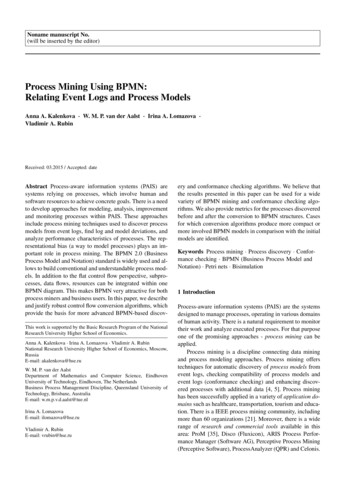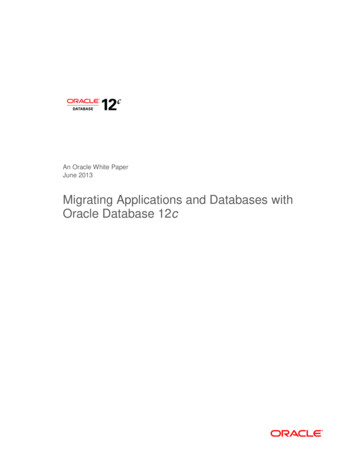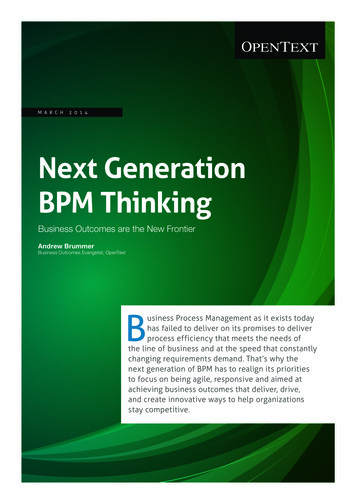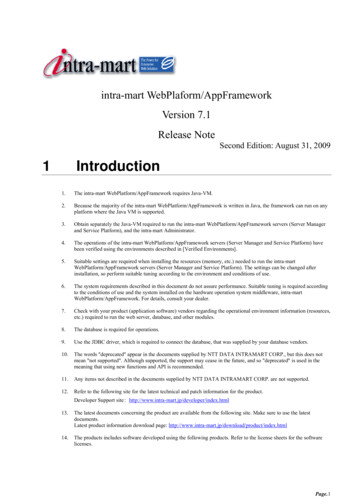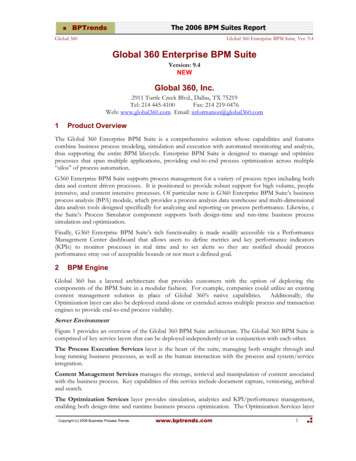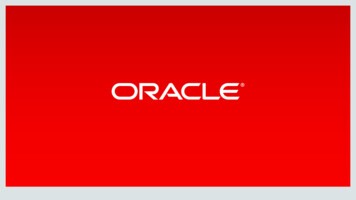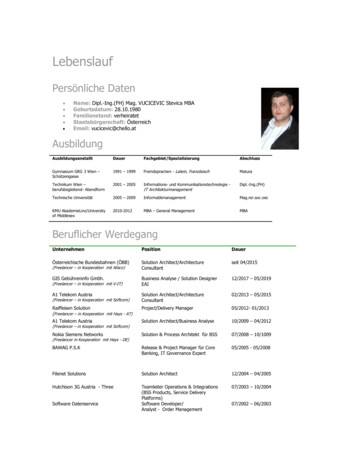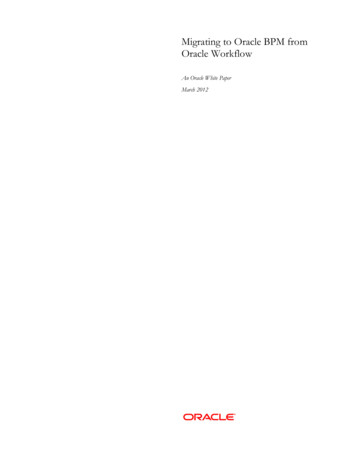
Transcription
Migrating to Oracle BPM fromOracle WorkflowAn Oracle White PaperMarch 2012
Migrating to Oracle BPM from Oracle WorkflowINTRODUCTIONOracle has always regarded process management as an important discipline topursue. More than a decade ago, Oracle released Oracle Workflow, a tool used tomanage traditional workflow chores and connect information flows betweenhuman workers and computer applications. It was essentially a database applicationand used a client tool, the Workflow Builder, a graphical modeling tool that letsusers create, view, or modify business processes using drag and drop operations.This workflow product was later on also embedded in the Oracle E-Business Suiteof applications for managing its workflows. Since then, the demands on processmanagement have increased, and standards for process modeling and executionhave emerged. Oracle is advising its customers using the Oracle Workflow versionthat is unattached to Oracle E-Business Suite also known as Standalone Workflowto consider migrating to the Oracle Business Process Management (BPM) Suite, thenext generation of process technology from Oracle. The Oracle BPM Suiteprovides an integrated environment for developing, administering, and usingbusiness applications centered on business processes.Oracle BPM simplifies achieving process management success with a completesolution for all types of processes by providing a unified process foundation, usercentric design, and social BPM interaction. It enables collaboration among processdevelopers and process analysts while maintaining concurrency throughout theprocess lifecycle. For process modeling and implementation, process analysts candesign business process models using Oracle BPM Studio, a tool installed as a plugin to Oracle JDeveloper. This is akin to the Workflow Builder modeling tool.Oracle BPM Studio supports Business Process Management Notation (BPMN) 2.0,a standard in modeling business processes. Moreover, BPM achieves persona-basedmodeling by also supporting a lightweight web browser-based interface that isdesigned mainly for business analysts more focused on process model and businesslogic. The Oracle BPM execution component provides a run-time environment forexecuting business processes in native BPMN notation. It also fulfills interactionswith Human Workflow for processes requiring human actions and Business Rulesfor processes involving dynamic decision-making. In other words, BPMN providesa modeling notation for capturing business processes and interactions, and througha combination of graphical and supporting elements, allows a model to bepopulated with sufficient information to generate executable runtime processes.Migrating to Oracle BPM from Oracle WorkflowPage 2
Because Oracle Workflow and BPMN are both fundamentally graph flowlanguages, a process that is implemented in one can be implemented in the other.However, they have different models and this paper is intended to provideguidance for those customers who are familiar with Oracle Workflow and will bedesigning and implementing BPMN processes, either brand new ones, or oneswhich will replace existing Oracle Workflow processes.This paper’s primary focus is on aspects that differ between the two products andthat developers should therefore be most aware of. It describes tips and bestpractices for migrating Oracle Workflows to Oracle BPM. It also describes featuresin Oracle BPM whose proper usage can ease this migration process.Migrating to Oracle BPM from Oracle WorkflowPage 3
HISTORICAL CONTEXT - STATEMENT OF DIRECTIONOracle has announced product obsolescence for Oracle Workflow. In a Statementof Direction published in January 2006, Oracle indicated that new development bycustomers of human-centric workflow should be done with Oracle BPEL ProcessManager. In a new SOD published in January 2007, Oracle recommended thatcustomers who have Oracle Workflow processes in development or productionthat they plan to continue to enhance in the future should begin re-implementingthose in BPEL. The SOD is available s/workflow-sod-089843.html.Since the SOD was published, Oracle’s process technology has evolved to positionOracle BPM in the forefront of business process management. With its support forgraph based BPMN language, Oracle BPM provides a significantly better migrationtarget than block structured BPEL, which is primarily an execution language usedfor orchestration of business services. Leveraging this support of BPMN, Oraclehas also included some migration utilities in its recent BPM releases.ORACLE BUSINESS PROCESS MANAGEMENT (BPM)The Oracle Business Process Management Suite is a complete set of tools forcreating, executing, and optimizing business processes. The suite enablescollaboration between Business and IT to automate and optimize businessprocesses.Figure 1: Oracle BPM Building BlocksThe Oracle BPM areas of functionality broadly include: Business driven Modelingo BPM Studio – JDeveloper-based design environment for IT andthe technical side of the business incorporating years of bestpractice modeling design. IT users have access to full set ofcapabilities ranging from Java and Web Services development toMigrating to Oracle BPM from Oracle WorkflowPage 4
BPMN and BPEL; particularly relevant is access to all of SOA’szero-code adapters, transformation, and other capabilities. Themodel that is designed in BPM Studio is a ‘what you see is whatyou execute’ (WYSIWYE) model that eliminates synchronizationissues between runtime and design time modifications – it is thesame model.o Process Composer – Targeted at line-of-business users, it allowsbusiness users to tailor-to-fit business processes and rules from aweb based tool. With nothing to deploy on user’s desktops,Process Composer enables a wide range of business participationwith role-based privileges on resources and functions much likeBPM Studio.BPM Runtimeo Designed for end-to-end process management and integrates withOracle and third party applications, and Business Intelligenceo Standards based – supports BPMN 2.0 native runtime engine,BPEL, WS-HumanTasko Pervasive use of Business Rules. A rich business friendly BusinessRules component is not only included and seamlessly integratedbut is also pervasively used for enabling truly dynamic BPM; suchusage includes – rules based workreassignment/delegation/balancing, rules based service selection,rules based task routing, rules based alert handlingo Being layered on Oracle SOA Suite, it provides enterprise-gradeperformance, scalability, reliability, and manageability.BPM Monitoring and Work Managemento BPM Workspace and Process Spaces – There are two flavors ofwork management portal available with Oracle BPM. The standalone work management portal is called BPM Workspace whichbusiness users can log into to perform tasks related to thebusiness process and view the process instance audit trailinformation. There is also another web 2.0 flavor of the workmanagement portal built on top of Oracle WebCenter calledProcess Spaces. Collaboration is a big focus of Process Spaces toensure business and information technology alignment. It enablesdifferent channels such as wiki’s, blogs and documentationaspects related to a specific process to be used as means ofcollaboration on a process.o Process Analysis – Process Analytics functionality within OracleBPM Suite provides process performance monitoring andbusiness monitoring through either BPM Workspace dashboardsor Oracle BAM (Business Activity Monitoring), anothercomponent of Oracle BPM Suite. Out-of-the-box metrics foractivities and processes include active instance count and averagetime to complete, broken out by process, activity, and participant.In addition to the predefined metrics, process designers canMigrating to Oracle BPM from Oracle WorkflowPage 5
create custom metrics using business indicators, a special type ofprocess variable for Process Analytics measures and dimensions.Figure 2: Collaborative Process DesignOracle BPM 11g is a gamechanger. It gives businessanalysts and executable processdevelopers a common processmodel based on the BPMN 2.0standard. At the same time, it isloaded with features for IT,starting with a world-class SOAFoundation Put it all togetherand Oracle BPM 11g is probably ayear ahead of its closestcompetitor— Bruce SilverFor more details, please see the Oracle BPM Datasheet /overview/bpm-datasheet132009.pdf and documentation /documentation/index.html. The pm/overview/index.html is agreat resource of information on Oracle BPM.This paper lays most of its focus on the modeling aspect of the processmanagement portfolio.BPMS WatchOVERVIEW OF BUSINESS PROCESS DESIGNBusiness Process Modeling Notation, commonly referred to as BPMN, is agraphical representation for specifying business processes in a business processmodel. It has emerged as the de-facto for modeling and is a core enabler of theBPM initiative in the Enterprise Architecture World and is broadly accepted.BPMN has built in support for asynchronous transactions, flow control, andcompensating transactions. BPMN leverages XPath, XSLT, and XQuery for datamanipulation.The primary BPMN elements include the following: Event – An event indicates something that happens during a process. Itsupports asynchronous communication with other processes, errorhandling and controlling flow logicMigrating to Oracle BPM from Oracle WorkflowPage 6
Activity – An activity represents the kind of work that needs to be done.These can be identified by different tasks, and sub-processes.Figure 3: Task Activities implemented in Oracle BPM Gateway – A gateway determines forking and merging of paths,depending on the conditions expressed Connecting Object – This is used to connect the above three elements toeach otherFigure 4: Sequence Flow BPMN Connection Object in Oracle BPMA Process describes a sequence or flow of activities in an organization with theobjective of carrying out work. A Process is depicted as a graph of Flow Elements,which are a set of Activities, Events, Gateways, and Sequence Flow. The sequenceflow represents the order in which Tasks are carried out.To learn more about BPMN, please visit the website at http://www.bpmn.org.The Sales Quote example project is a real-world example of a business processusing Oracle BPM features.Migrating to Oracle BPM from Oracle WorkflowPage 7
Figure 5: Oracle BPM: The Sales Quote Example ProjectHUMAN TASKS IN BPMHuman tasks in BPM are fulfilled by the implementation of user tasks. Humantasks can be added by using a simplified interface within Oracle BPM. At runtime,when the flow control arrives at a user task, the control is passed from the BPMNprocess to the Oracle Human Workflow, and the control gets passed back to theBPMN process once the Human Tasks are completed. The Human WorkflowService is then responsible for routing the task to the various users, notifying them,and so on.Migrating to Oracle BPM from Oracle WorkflowPage 8
Figure 6: Human Workflow OverviewIn summary, human tasks are modeled using a Human Task activity - the routing,assignment, notifications, escalation and other metadata is stored in a .task file, andat run time users can log into a Task List application to find and perform work.Some of the salient features of the Human Workflow component are: Declarative pattern based routing – Common patterns such asManagement Chain Escalation and Group Voting can be declarativelyspecified. Multiple patterns can be combined for sophisticated routingpatterns. Assignment – Tasks may be assigned to individuals or groups (roles).Tasks may also be assigned dynamically based on process data enablingplugging in of any other assignment engine or rules based assignment. Nomination, Delegation and Reassignment – Supervisors and processowners may nominate or delegate tasks. Also, group owners may specifyreassignment rules for redistributing work assigned to a group based onvarious load balancing algorithms. The reassignment feature addresses thescenarios addressed by the Role Resolution feature in Oracle Workflow. Declarative Escalations and Notifications – Escalations, notifications, andreminders may be declaratively specified. Rich set of notifications issupported and email notifications may be made actionable allowingsomeone to complete their task from their email.Migrating to Oracle BPM from Oracle WorkflowPage 9
For more details, please visit the Oracle Human Workflow page anworkflow/overview/index.html.BUSINESS RULESBusiness Rules is becoming a key component in a process-based applicationdevelopment. They can help capture complex decision-making mechanisms. Theycan help model business or process flow control logic including human taskassignment. Business rules can be externalized, and hence execution behavior of theprocess-based application can be changed without any redeployment of the BPMproject itself. Oracle BPM Suite includes an easy-to-use business rules componentthat is available via BPM Studio as well as through Process Composer. Thecomponent can model both if-then-action as well as the decision-table.Figure 7: Oracle BPM: Built-In Business RulesMIGRATION OUTLINEProcess MigrationStep 1. Classify Workflow Process: The first step in the migration shouldbe to understand your Oracle Workflow Processes and classify themwith the goal of identifying the right target technology. OracleWorkflow Processes may fall in the following categories: Process Navigator Flows: These should either be converted intoADF Task Flows for cases which warrant a modular approach fordefining control flows or to Activity Guides in BPM Suite whenthe flow is a large-scale, long-running, multiuser process thatMigrating to Oracle BPM from Oracle WorkflowPage 10
consumes and reuses various task flows and process orchestrationis the controlling agent for the business process across multipledisparate systems. Page Flows: These should be migrated to ADF Task Flows. Simple Deferred Activities: If you are using Workflow to simplyperform some DML activities on your tables, then you may wantFigure 8: Example of a simple deferred activityto not convert these to BPMN but rather raise an event, and useMediator to invoke the needed activities on event receipt. If youchoose, you can use BPMN as well. XML Transaction Flows: If you are using Oracle Workflow tomodel XML Transactions, you may want to simply use thetransformation capabilities of Oracle Mediator. If you choose,you can use BPMN as well. Business Processes: Generally speaking these are theorchestration of system services and human tasks includingapprovals. This category should be migrated to BPMN asdescribed in this document. Identify Business Services: Identify all the PL/SQL proceduresand functions you are calling from Workflow. You should be ableto call these directly from BPMN using either the DB adapter orApplications adapter, if the interaction is based on Oracle EBusiness Suite. However, if you are accessing or setting item typefrom within your PL/SQL code you will need to change them asdescribed in section Data Access below. In addition, all workflowMigrating to Oracle BPM from Oracle WorkflowPage 11
dependencies e.g. calls to workflow engine APIs, will need to bereplaced. Identify all third-party APIs you are calling from Workflow. Youshould be able to call them from BPMN using the rich set ofadapters provided in BPMN.Step 2. Identify Users/Group Roles setup: See section on Roles, Usersand Groups described below.Step 3. Identify Workflow Dependencies:i. If you are using any Workflow engine APIs in yourapplication code, some of these will need to bemodified to use corresponding BPM XPathExtension functions or the native functionalityprovided by BPMN. BPM XPath functions enablethe access of process and process data objects,arguments, and activity instance attributes.ii. Oracle BPM 11g includes a set of APIs that can beused to create and query process instances. Theseare documented suite/documentation/bpm-e25378-01-488744.zipStep 4. Identify key Business Rules: You may want to implement the keybusiness rules using Oracle Business Rules. Doing so externalizes thebusiness rules – that is, by setting them outside of the proceduralprocess model, runtime behavior of a process can be changed withoutthe need to redeploy the BPM project. See the section on BusinessRules above.Step 5. Identify Approval Logic: Human Workflow enables powerfuldeclarative pattern based approval. You may simplify the approvallogic as described in Approval Flow (Human Workflow) below.Step 6. Define Process Variables to be used: Understand the shape of thedata variables that you will need and define the structure of thesevariables. These essentially get passed and used as Data Objects withinBPMN.Step 7. Define BPMN Process Flow: Understand the current flow anddefine it in BPMN. As of BPM 11gPS4FP, users can import existingOracle Workflow models into BPM Studio 11g. This import processis described rt. It uses the sample Workflowdemo process WFDEMO.wft as an example. The import processMigrating to Oracle BPM from Oracle WorkflowPage 12
establishes a basis for your migration process and is a starting pointfor subsequent implementation in BPMN. The section on Controlflow below discusses the semantic differences between OWF flow andBPMN flow and how to map OWF Flow to BPMN flow.Step 8. Fill out BPMN Details: Add BPMN details per the mappingoutlined in section Constructs Mapping below.Step 9. Deploy: Deploy the BPMN Process.Data MigrationDue to the differences in the Oracle Workflow process and migrated BPMNprocess, it is not recommended to attempt migrating run time data from WorkflowTables to BPMN Runtime Tables. The value of the run time historical data isprimarily for analytic purposes; therefore, instead plan on migrating runtime data tothe appropriate analytic warehouse schema.CONCEPTS MAPPINGControl FlowLike in Oracle Workflow, BPMN provides different structures to control the flowof a process. These structures enable decisions as to which path a process instancetakes based on different conditions. These structures are flow objects in the formof gateways which enable you to fork the flow of a process, timer events whichdefine a path based on time conditions, message events based on the occurrence ofa certain event, errors, and loop markers amongst others. Provided below is a briefdescription for each of these constructs:LoopsIn Oracle Workflow, loops are designed as a loop counter activity. A Loop Counteractivity may be used to control the allowed number of iterations.Figure 9: Oracle Workflow: Example Loop Counter Activity in a BranchMigrating to Oracle BPM from Oracle WorkflowPage 13
In BPMN, loop markers enable a sub process to run multiple times based on acertain condition or expression which has to be explicitly set. The loop marker canbe configured to stop after a certain number of repetitions. The activities formingthe loop in Oracle Workflow should be modeled as a looping sub-process with aloop condition specifying the number of loops. In addition, multi-instance markerscan be configured to run a sub process for each of the elements on a set of data.Figure 10: BPMN Loops using Loop Marker for a Sub-ProcessTransitions / BranchingIn Oracle Workflow, multiple transitions may be drawn from a node based on itsresult lookup as well as Any, Default, and Timeout. Parallel branching is implicitlydefined if more than one transition is enabled (Any in parallel with Result basedtransition).Figure 11: Transitions/Branching in Oracle WorkflowIn BPMN, sequence flows connect the flow objects within a process, anddetermine the path a process token follows through the process. Sequence flowscan be conditional or unconditional. Conditional sequence flows can be used tocontrol the flow of a process based on defined conditions or expressions. Parallelpaths in a process can be configured using parallel gateways which allow splittingup the process into two or more paths and when it is needed that all the paths befollowed simultaneously.Migrating to Oracle BPM from Oracle WorkflowPage 14
Figure 12: Transitions/Branching in BPMNTimeout TransitionsIn Oracle Workflow, Timeout transitions are drawn from a notification activity tosome other activity to force the process to perform the other activity if thenotification activity does not complete by a specific period of time.Figure 13: Notification Timeout in Oracle WorkflowNotification Timeout intervals can be defined declaratively within a single approvaluser task in Oracle BPM and the above Workflow model defined as shown below.Figure 14: Notification Timeout defined within User Task in Oracle BPMMigrating to Oracle BPM from Oracle WorkflowPage 15
Email NotificationsOracle Workflow implementations use email notifications prominently to designatea role to perform some human activity or simply to relay process-relatedinformation.In Oracle BPM, the Notification Task can be used to configure notifications via email, SMS, voice or IM. The roles for these are defined in an LDAP. Also seesection on Roles, Users, and Groups described below. In addition, Human Tasksallow you to configure notifications to a user or role to let the user know when thestatus of the task changes.ErrorsOracle Workflow allows defining the processing that should occur in case of anerror by specifying an error handling process when a workflow process is beingbuilt.Similarly, within BPMN, error events enable you to define how a process handlesan abnormal situation. You can use error events to define different process flowsfor each of the errors that may occur in a business process. See section on ErrorHandling below.Message EventsThe concept of Message Events is similar in Oracle Workflow and in BPMN.Mapping Oracle Workflow Control Flow to BPMN Control Flow1.Understand the logic of your Oracle Workflow Control flow.2.Identify the loops and looping conditions. Model these in BPMN byspecifying looping conditions3.Identify the fan-out points. Understand whether the fan-out is conditionalbranching or parallel branching. Identify the matching fan-in points.Model in BPMN using gateways.4.Identify the usage of notification activities in Oracle Workflow. Theequivalent functionality should be modeled using the Human Task Editor.5.It is important to discern certain flow patterns within Oracle Workflowwhich can be equivalently modeled using tasks within Oracle BPM usingdeclarative data. See the Approval Flow section below.6.Error processes should be replaced to use error events in BPMN7.All the message events should be identified and translated into themessage event in BPMN that maps directly to functionality provided byOracle Workflow.Migrating to Oracle BPM from Oracle WorkflowPage 16
Data AccessIn Oracle Workflow, invoked PL/SQL code may access the Item attributes usingWF ENGINE APIs. Also, each activity returns a result suitable for result basedtransitioning.procedure UpdateStatus (itemtype in varchar2,itemkey in varchar2,actid in number,funcmode in varchar2,resultout out varchar2) isl po number varchar2(20);l po status varchar2(20);beginif ( funcmode 'RUN' )thenl po number : wf engine.getitemattrtext(itemtype, itemkey, ‘PO NUMBER)’l po status : wf engine.getactivityattrtext(itemtype, itemkey, actid,‘PO STATUS)’PO PKG.UpdateStatus(l po number,l po status);resultout : 'COMPLETE: result ';return;end if;end;Figure 15: Data access in OWF within PL/SQL using WF ENGINE APIMigrating to Oracle BPM from Oracle WorkflowPage 17
In BPMN, the invoked activity cannot access process data. Any data it needsshould be passed in as its input arguments via data associations and any data itneeds to set should be passed as output arguments to the next flow objectimplementation. Note that the output of a BPMN activity is not limited to lookups.Alternatively, the data should be externalized and stored in a database from whereboth the process and the activity can access it.Figure 16: Arguments and Data Objects in BPMNRoles, Users and GroupsOracle Workflow users and roles are stored in the database, in the OracleWorkflow directory service. Oracle Workflow references this user and roleinformation through the views WF USERS (individual users), WF ROLES (roles,which can have one or more users as members), and WF USER ROLES(associations of users with the roles).Oracle BPM Suite leverages users, groups, and organizational hierarchiesmaintained in an organization’s preferred identity store. In addition, processspecific roles can also be defined within BPM Suite 11g. In Oracle BPM, the areasof responsibility are mimicked by roles used to define initial participants in humantasks in the process. Roles are of two types: Application roles that are based on aBPM project, and Enterprise roles that are defined externally in an LDAP store. ABPM role has one or more users or groups assigned to it. Roles are logical andwhen the Oracle BPM project is deployed, the roles get mapped to LDAP roles orgroups that correspond to users in a real-world organization.Migrating to Oracle BPM from Oracle WorkflowPage 18
Approval Flow (Human Workflow)In Oracle Workflow, Approvals were modeled using complex loops, wait activities,notification activities, timeouts, etc.Figure 17: Approval Flow in Oracle WorkflowThe Human Workflow component which is callable from a BPMN process enablesmost such flows to be modeled as tasks with declarative metadata which identifiesuser task extensions based on workflow approval patterns: User Task (Single Approver) Management Task (Sequential Management Chain) Voting Task (Parallel Voting Group) FYI Task (FYI Pattern) Complex Task (Full-fledged task editor) Initiate Task (User Initiate Task)This in-built declarative support for human workflow patterns makes processvisualization simpler and less prone to errors.Migrating to Oracle BPM from Oracle WorkflowPage 19
Figure 18: Patterns and Rule Based RoutingError HandlingError handling in Oracle Workflow is specified in an Error process. OracleWorkflow does not allow errors to be returned to callers. Instead, it lets developersdefine an error handling process assigned to a process, function, or event activity.Exception Handling in BPM Suite can be done either by explicitly modelingbusiness exceptions and associated process paths using BPMN constructs such as“catch” and “throw” events or by using policy-driven declarative exceptionhandling. An exception handling policy, called the Fault Policy, contains one ormore policies that define exceptions to be caught and the actions to be taken whensuch exceptions occur. The exception handling framework provides a choice ofvarious actions such as retry, abort, and human intervention via Oracle EnterpriseManager, and custom actions created using Java. The policies are stored completelyseparated from the process, thus allowing nonintrusive exception handling. Thispolicy-based exception handling strategy is typically well suited for system levelexceptions, while business exceptions including situations where compensationlogic may be needed are usually better handled via BPMN-based patterns andapplied where the exception is raised from.Migrating to Oracle BPM from Oracle WorkflowPage 20
Figure 19: Exception Handling in Oracle BPMProcess Tracking, Monitoring and AdministrationOracle Workflow includes an Administrator Monitor component that lets usersview and administer run time workflows.Within Oracle BPM Suite, Process Work Spaces provides a customizable singleinterface for collaborative business process management. It brings up an active tasklist, a calendar showing a participant’s to-do list based on the progress of thebusiness process, a dashboard showing business process metrics, and others. To aidcollaboration on a business process, it also provides discussions, documentattachments, and other items that are tightly integrated with the business process.Process Spaces creates one out-of-box Process Work Spaces at installation, whereprocess workers sign in to access items related to their work and preference. Therealso exists Process Instance Spaces, a dynamically created WebCenter Spaces forcollaborating on a specific instance of a business process. A process worker canspin off an Instance Spaces for a particular process instance they he may beworking on.Migrating to Oracle BPM from Oracle WorkflowPage 21
Figure 20: Process Work SpaceFor finer-grained component-level flow-trace tracking, users have access to a single,monitoring, and management console provided by Oracle Enterprise Manager(EM). EM also allows system administrators to monitor and manage the health ofthe Oracle BPM system.Figure 21: Process Audit Flow Trace in Oracle Enterprise ManagerCONSTRUCTS MAPPINGOverviewThe following section provides a description of how Oracle Workflow constructsmap to BPMN constructs:Function Activity - PL/SQL and JavaWhen a workflow engine calls a stored procedure from a function activity, it usuallypasses in the item type and item key to the procedure. It also may accept a resultwhen the procedure completes, which determines the next transition activity withinthe workflow. Within the procedure itself, there may be call outs to several of theMigrating to Oracle BPM from Oracle WorkflowPage 22
workflow engine APIs. Custom Java classes can also be created to be called byexternal Java function activities.Workflow function activities calling PL/SQL code that does not make anyreferences to workflow engine APIs may be mapped to a BPMN service task asfollows:Step 1. Within the
This is akin to the Workflow Builder modeling tool. Oracle BPM Studio supports Business Process Management Notation (BPMN) 2.0, a standard in modeling business processes. Moreover, BPM achieves persona-based modeling by also supporting a lightweight web browser-based interface that is designed mainly for business analysts more focused on process model and business logic. The Oracle BPM .
